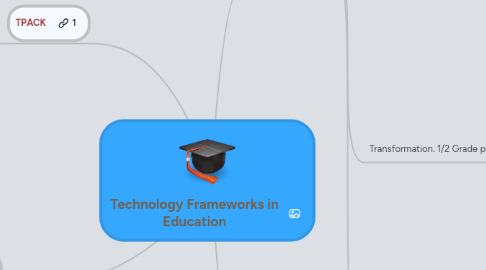
1. 21st Century Learning
1.1. 3 Main Points
1.1.1. Foundational Knowledge.
1.1.1.1. Content, Information Literacy, Cross-disciplinary Knowledge.
1.1.2. Meta Knowledge
1.1.2.1. Problem Solving.
1.1.2.1.1. Four C's
1.1.3. Humanistic Knowledge
1.1.3.1. Life/Job skills, Cultural competence, Ethical/Emotional Awareness
1.2. Outcomes:
1.2.1. Learning and Innovation skills
1.2.2. Life and Career Skills
1.2.3. Information, Media, and Technology Skills.
1.2.4. Core subjects
1.2.4.1. Three R's and 21st Century themes
2. TPACK
2.1. Technological Knowledge (TK)
2.1.1. Knowledge of technological tools and how to use them.
2.1.2. Do the tools do what I think it can and can both I and my students use it?
2.2. Pedagogical Knowledge (PK)
2.2.1. How a teacher teaches
2.2.2. Are the tasks clear, well suited and well ordered?
2.3. Content Knowledge (CK)
2.3.1. What a teacher knows.
2.3.2. What students know. Does teacher have to back track before explaining a certain concept.
2.4. Old model framework for using technology in education.
3. Philosophy of Technology
3.1. A teachers personal philosophy on how they use technology in the classroom. These philosophies grow and change with time.
3.1.1. My Personal Philosophy on Technology
3.1.1.1. My aim as a teacher is to teach. But not to just teach a subject but also skills that will help my students further in life, to create a challenge and an environment where knowledge is abundant for those searching. To use technology to enhance this learning and help students become interactive and really work with a subject.
4. SAMR
4.1. Enhancement. No grade effect
4.1.1. Substitution
4.1.1.1. Computer used to perform tasks that can be completed without computers.
4.1.1.1.1. Printing worksheets and tests
4.1.1.1.2. Teacher centered. Eases the workload but can be completed without.
4.1.1.1.3. No real gain from technology
4.1.1.1.4. Students do not come in contact with the technology used. If they do it does not benefit them.
4.1.2. Augmentation
4.1.2.1. Technology used to preform a task that could be completed without a computer
4.1.2.1.1. This includes tasks such as taking tests online or online homework.
4.1.2.1.2. There is no real gain for the student from the technology. Gain to environment and to teacher.
4.1.2.1.3. Feedback is faster, when technology is used in this way because it does not require the teacher to do much work to provide feedback.
4.1.2.1.4. Increase in functionality
4.1.3. Teacher questions and students respond. This provides a less interactive learning process.
4.2. Transformation. 1/2 Grade point jump.
4.2.1. Modification
4.2.1.1. Assignments are completed with the use of technology. It enhances the assignment in ways that would be close to impossible without the use of technology.
4.2.1.1.1. Creates a more interactive assignment.
4.2.1.1.2. Students learn similar skills expected of them in normal projects but with the added reality of an authentic audience.
4.2.1.1.3. Technology allows for a redesign of the task at hand.
4.2.2. Redefinition
4.2.2.1. This level is completely impossible without the use of technology.
4.2.2.1.1. For instance, a student or students creating a video that explore a subject in depth.
4.2.2.1.2. Collaboration of ideas to complete project becomes necessary.
4.2.2.1.3. Technology supports students learning and is needed to complete assignments.
4.2.2.1.4. Can connect to students around the world.
4.2.3. We see students getting involved with transformation because their projects become more personal. Students questions become more frequent as they have personal stake in the assignment.
